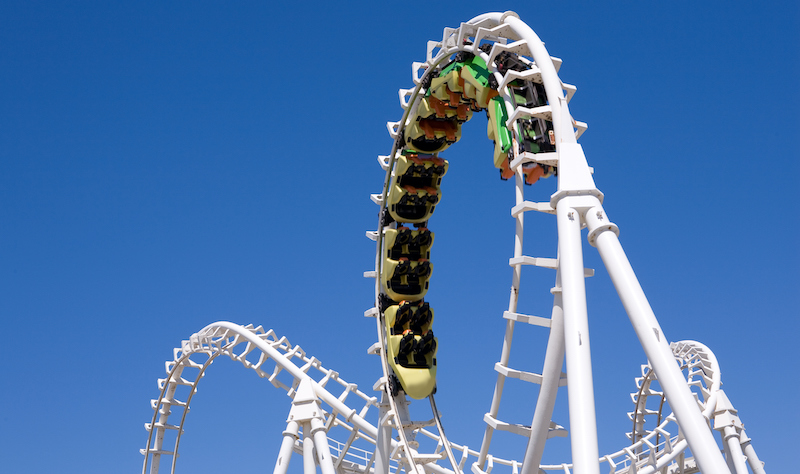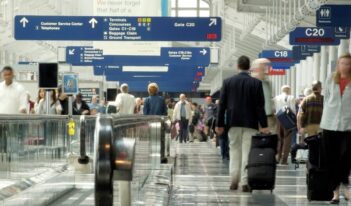
A patchwork of state and private industry oversight leaves room for federal intervention.
Who makes sure amusement park rides are safe?
In what might be a surprise to riders, most amusement park rides are not federally regulated. Although the Consumer Product Safety Commission (CPSC) oversees mobile amusement rides and carnival attractions that travel from state to state, fixed-site amusement ride regulation, like those at theme parks, is left to the states.
The International Association of Amusement Parks and Attractions (IAAPA), a trade association representing amusement parks, reports that 44 states regulate amusement rides. The six states that completely lack state oversight—Alabama, Mississippi, Montana, Nevada, Wyoming, and Utah—contain either very few or no amusement parks.
But among those 44 states, ride regulation can vary widely. According to Safety Park USA, an insurance and risk management company for the amusement industry, only 20 states demonstrate “comprehensive government oversight.” These states require regular inspections from a government agency and empower the state government to investigate accidents.
Pennsylvania, for example, is one of the states identified with a comprehensive oversight program. The Pennsylvania Amusement Ride Safety Advisory Board meets quarterly to review all new rides and attractions applying to operate in the state, and rides are inspected monthly by state-certified third-party inspectors at the ride owner’s expense.
On the other end of the spectrum, a lack of state oversight can lead to tragedy. In Kansas, a 10-year-old boy was decapitated on a 168-foot-tall water slide in 2016. In the two years the ride was open prior to his death, 13 people had been seriously injured on the ride—but the state never inspected it.
Kansas did require annual exams by private inspectors, but these reports did not have to be shared with state officials. The state also lacked height restrictions on water park rides. The park’s owner and ride designer were indicted for second-degree murder, but the charges were dismissed due in part to a ruling that the grand jury had received improper evidence.
The Kansas tragedy does illustrate how ride owners, operators, and designers can face civil claims or criminal charges when their rides cause serious injuries. But it often takes tragic accidents that trigger a public outcry for states to strengthen their regulatory oversight. Following the Kansas tragedy, the state’s legislature overwhelmingly passed the Kansas Amusement Ride Act in 2017, which tightened inspection requirements and mandates parks to report injuries to the state.
To standardize rides and inspection design and safety elements across amusement parks, the industry typically relies on guidance from ASTM International, an organization that develops voluntary consensus standards for a wide variety of products and systems.
ASTM International’s committee on amusement rides meets twice each year to update a set of voluntary performance specifications, maintenance guides, and other ride safety standards that are published in the Annual Book of ASTM Standards. These industry standards are widely followed by amusement parks in the United States—in fact, even state laws will sometimes incorporate them into regulatory requirements. Approximately 35 states reference ASTM standards in their regulations for ride safety.
Many of the state agencies regulating amusement rides are housed within state departments of agriculture. Historically, amusement parks were traveling businesses that set up at state fairs where farmers brought their prized produce and showmen brought rides to entertain the crowds. These fairs and events were often overseen by agricultural departments, leading to the modern regulatory framework of state supervision.
That regulatory framework added a federal layer when the U.S. Congress established the CPSC in 1972. The agency initially regulated both mobile and fixed-site amusement rides, but the CPSC’s authority to inspect fixed amusement park rides was routinely challenged in court. The amusement park industry advocated changes to remove CPSC oversight of fixed-site rides, and in 1981 Congress passed these changes—since deemed the “roller coaster loophole.”
Proposals to close the roller coaster loophole are straightforward. A legislative fix would amend two sentences of the Consumer Product Safety Act, removing the exception for “a device which is permanently fixed to a site.”
U.S. Senator Ed Markey (D-Mass.) has repeatedly introduced legislation to restore the CPSC’s oversight of fixed-site rides. Proposing legislation in 2001, he argued that “the reason there is no national clearinghouse to prevent ride injuries is clear—since 1981, the industry has escaped routine product safety regulation through a loophole in the law.”
Senator Markey began his crusade for federal oversight in 1999, and the industry has opposed him since. IAAPA spends approximately $600,000 a year lobbying against federal oversight, and the association continues to lobby to maintain the status quo of state and industry oversight. “It’s like the fox guarding the henhouse,” said Mark Bayer, Senator Markey’s former chief of staff.
One big problem in the regulatory patchwork is also the lack of transparent data concerning ride accidents. No agency or organization fully captures uniform statistics on accidents or injuries across the hundreds of U.S. amusement parks.
IAAPA conducts an annual safety survey which reports a strong safety record. The chance of being seriously injured on a fixed-site ride at a U.S. amusement park is 1 in 15.5 million rides taken. But the survey is optional. Only 177 of 436 invited parks submitted ride safety data for the 2019 survey, the last report to include ridership levels from before the COVID-19 pandemic.
The CPSC estimated in 2015 that approximately 37,000 people visited an emergency room that year after being hurt on amusement rides. These data were collected through the National Electronic Injury Surveillance System, although these estimates include bounce houses and mechanical bulls in the same category code as an amusement ride.
A 2013 study published in Clinical Pediatrics revealed that nearly 100,000 children were treated for amusement ride-related injuries in the United States between 1990 and 2010—33% of which occurred on fixed-site rides. The study concluded that “an improved national system for monitoring injuries involving amusement rides is needed.”
IAAPA notes, however, that a 2003 panel led by the Brian Injury Association of America found that the risk of roller coaster-related brain injuries and fatalities is “in the rider and not the ride,” concluding that it is unlikely a federal agency could match the effectiveness of the current regulatory system.



